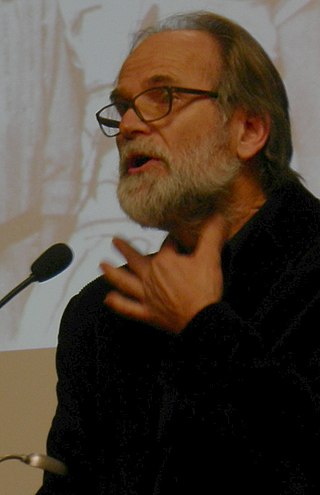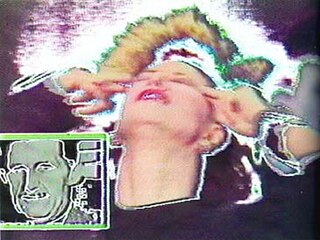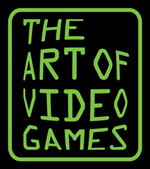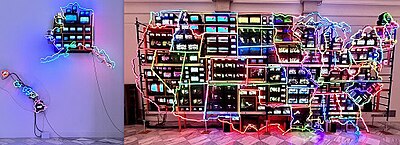Video art is an art form which relies on using video technology as a visual and audio medium. Video art emerged during the late 1960s as new consumer video technology such as video tape recorders became available outside corporate broadcasting. Video art can take many forms: recordings that are broadcast; installations viewed in galleries or museums; works streamed online, distributed as video tapes, or DVDs; and performances which may incorporate one or more television sets, video monitors, and projections, displaying live or recorded images and sounds.

Nam June Paik was a Korean artist. He worked with a variety of media and is considered to be the founder of video art. He is credited with the first use (1974) of the term "electronic super highway" to describe the future of telecommunications.
The information superhighway is a late-20th-century phrase that aspirationally referred to the increasingly mainstream availability of digital communication systems.

The Smithsonian American Art Museum is a museum in Washington, D.C., part of the Smithsonian Institution. Together with its branch museum, the Renwick Gallery, SAAM holds one of the world's largest and most inclusive collections of art, from the colonial period to the present, made in the United States. More than 7,000 artists are represented in the museum's collection. Most exhibitions are held in the museum's main building, the Old Patent Office Building, while craft-focused exhibitions are shown in the Renwick Gallery.
Video installation is a contemporary art form that combines video technology with installation art, making use of all aspects of the surrounding environment to affect the audience. Tracing its origins to the birth of video art in the 1970s, it has increased in popularity as digital video production technology has become more readily accessible. Today, video installation is ubiquitous and visible in a range of environments—from galleries and museums to an expanded field that includes site-specific work in urban or industrial landscapes. Popular formats include monitor work, projection, and performance. The only requirements are electricity and darkness.

Trimpin is a German born kinetic sculptor, sound artist, and musician currently living in Seattle and Tieton, Washington.

The National Museum of African Art is the Smithsonian Institution's African art museum, located on the National Mall of the United States capital. Its collections include 9,000 works of traditional and contemporary African art from both Sub-Saharan and North Africa, 300,000 photographs, and 50,000 library volumes. It was the first institution dedicated to African art in the United States and remains the largest collection. The Washington Post called the museum a mainstay in the international art world and the main venue for contemporary African art in the United States.

The Renwick Gallery is a branch of the Smithsonian American Art Museum located in Washington, D.C. that displays American craft and decorative arts from the 19th to 21st century. The gallery is housed in a National Historic Landmark building that was opened in 1859 on Pennsylvania Avenue and originally housed the Corcoran Gallery of Art. When it was built in 1859, it was called "the American Louvre", and is now named for its architect James Renwick, Jr.

Shigeko Kubota was a Japanese video artist, sculptor and avant-garde performance artist, who mostly lived in New York City. She was one of the first artists to adopt the portable video camera Sony Portapak in 1970, likening it to a "new paintbrush." Kubota is known for constructing sculptural installations with a strong DIY aesthetic, which include sculptures with embedded monitors playing her original videos. She was a key member and influence on Fluxus, the international group of avant-garde artists centered on George Maciunas, having been involved with the group since witnessing John Cage perform in Tokyo in 1962 and subsequently moving to New York in 1964. She was closely associated with George Brecht, Jackson Mac Low, John Cage, Joe Jones, Nam June Paik, and Ay-O, among other members of Fluxus. Kubota was deemed "Vice Chairman" of the Fluxus Organization by Maciunas.

Doug Aitken is an American multidisciplinary artist. Aitken's body of work ranges from photography, print media, sculpture, and architectural interventions, to narrative films, sound, single and multi-channel video works, installations, and live performance. He currently lives in Venice, California, and New York City.

"Good Morning, Mr. Orwell" was the first international satellite "installation" by Nam June Paik, a South Korean-born American artist often credited with inventing video art. It occurred on New Year's Day, 1984.

A video sculpture is a type of video installation that integrates video into an object, environment, site or performance. The nature of video sculpture is that it utilizes the material of video in an innovative way in space and time, different from the standard traditional narrative screening where the video has a beginning and end.

Nick Cave is an American sculptor, dancer, performance artist, and professor. He is best known for his Soundsuit series: wearable assemblage fabric sculptures that are bright, whimsical, and other-worldly, often made with found objects. He also trained as a dancer with Alvin Ailey and often incorporates dance and performance into his works. His later sculptures have focused on color theory and included mixed media and large-scale installations. He lives in Chicago, Illinois, and directs the graduate fashion program at the School of the Art Institute of Chicago. He continues to work on Soundsuits as well as works completed as a sculptor, dancer, and performance artist.

The Art of Video Games was an exhibition by the Smithsonian American Art Museum which was on display March 16–September 30, 2012. The exhibition was designed to highlight the evolution of art within the video game medium over its forty-year history. Following its time at the Smithsonian American Art Museum, the exhibition toured to 10 additional venues in the United States. Chris Melissinos, founder of Past Pixels and collector of video games and gaming systems, was the curator of the exhibition.
Electronic Arts Intermix (EAI) is a nonprofit arts organization that is a resource for video and media art. An advocate of media art and artists since 1971, EAI's core program is the distribution and preservation of a collection of over 3,500 new and historical video works by artists. EAI has supported the creation, exhibition, distribution and preservation of video art, and more recently, digital art projects.
Electronic superhighway may refer to:
John G. Hanhardt is an American author, art historian, and curator of film and media arts. Hanhardt was the Consulting Senior Curator for Media Arts at the Smithsonian Museum of American Art, where he developed exhibitions, collections, and archives in film and the media arts. He is considered to be one of the leading scholars on video artist Nam June Paik.

Larry Miller is an American artist, most strongly linked to the Fluxus movement after 1969. He is "an intermedia artist whose work questions the borders between artistic, scientific and theological disciplines. He was in the vanguard of using DNA and genetic technologies as new art media." Electronic Arts Intermix, a pioneering international resource for video and new media art has said, "Miller has produced a diverse body of experimental art works as a key figure in the emergent installation and performance movements in New York in the 1970s... His installations and performances have integrated diverse mediums [sic] and materials."

John Sanborn is a key member of the second wave of American video artists that includes Bill Viola, Gary Hill, Dara Birnbaum and Tony Oursler. Sanborn's body of work spans the early days of experimental video art in the 1970s through the heyday of MTV music/videos and interactive art to digital media art of today.

The More, the Better, alternatively referred to as Dadaikseon (Korean: 다다익선), is a video sculpture created by Nam June Paik for the purpose of the National Museum of Modern and Contemporary Art during the 1988 Summer Olympics. The sculpture consists of a tower measuring 8.5 meters in height and 11 meters in diameter, adorned entirely with an impressive arrangement of 1,003 cathode ray tube (CRT) television monitors. The work still stands in the rotunda of the National Museum of Modern and Contemporary Art in Gwacheon, Gyeonggi Province, South Korea.















